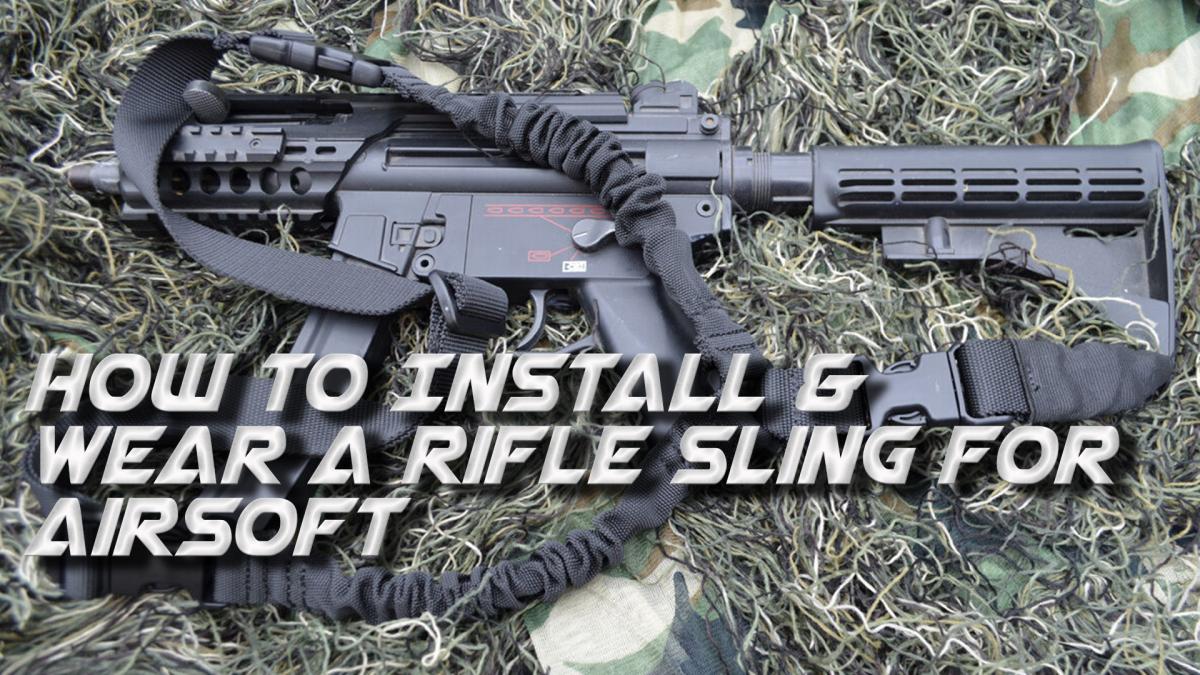How to Install & Wear a Rifle Sling for Airsoft
Rifle slings have been considered an essential item for firearms for as long as firearms have existed. Soldiers and hunters travelling long distances have always needed a method to securely carry their weapons on their backs without the use of their hands to prevent any added fatigue and a sling has always been the most efficient method of doing it. Slings have come in many forms ranging from traditional two point slings on muskets and long rifles to newer single and three point slings used for either retention or adjustable for different situations.
Do I Need a Rifle Sling for Airsoft?
Now naturally most airsoft players are unlikely to be marching across vast distances, however a rifle sling is still extremely useful for either moving from A to B with your weapon or freeing up your hands for other temporary tasks while keeping the weapon on your person. In addition, a sling is extremely advantageous when transitioning from your primary to your secondary sidearm in the heat of the moment as it prevents your potentially expensive airsoft rifle from being dropped onto the ground where it could get dirty or damaged. The sling also allows you to quickly transition back to your primary weapon and reload once the threat has subsided; keeping everything on your body without having to go back and retrieve the weapon you left on the ground which could become lost during the action.
What Type of Rifle Slings Should I consider?
There are three main types of rifle slings that you will likely encounter, these are mainly defined by the number of attachments points they come with in the form of one-point, two-point or three-point slings.
The choice of sling, of course, depends on personal preferences, but it is worth noting that, depending on the type, specific models work better or worse in certain situations depending on the firearm it is attached to. Most importantly however, you should remember to choose models of slings from reputable manufacturers which will guarantee reliability; counterfeit constructions may imitate the original form but will never achieve comparable quality to an original especially if it breaks after a few weeks of use.
1 Point Rifle Sling
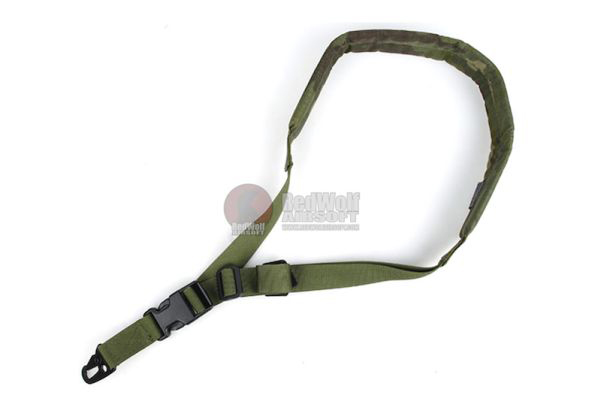
Single point slings attach to a single point on the weapon. This allows for a robust and straightforward type of sling that is easy to use by anyone. The sling attaches to the rear of the firearm and typically features a loop that goes around the body over one arm and under the other. Single point slings are also an excellent choice for tactical shooting and do have some limited hunting applications.
Single point slings are very easy to use and allow you to don and remove your sling with minimal effort quickly. The sling always makes it very easy to manoeuvre the weapon, especially when it comes to indoor use. Since the sling only attaches to the rear of the gun, the muzzle is entirely free and allows for transitioning from shoulder to shoulder smoothly enabling you to shoot around barriers. The single point sling offers the enormous range of movement for shooters of all three sling types. They are very simple and will not likely get tangled up in your gear as you move.
The main disadvantage of a single point sling is when you aren’t handling the weapon; a rifle with single point sling kind of just flops around which reduces the ability to have your hands free for doing other tasks. For male shooters in particular, this could result in some uncomfortable blows to your nether regions. Single point slings are the least ideal for prolonged use and are the hardest to climb with and difficult to get up and over an obstacle as the lack of control will result in your weapon bouncing off obstacles.
2 Point Rifle Sling
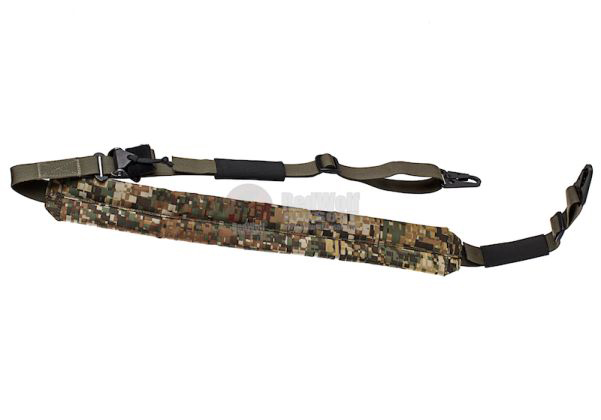
Two point slings are the most common sling in existence and have been around since the dawn of firearms. The name comes to the fact the sling attaches to two points on the rifle. These slings vary greatly in design and function but are popular for hunting and tactical use.
Two point slings offer a massive amount of support and adjustment. They can keep the weapon from moving and keep it tight to the body when it's not being gripped. It is also easy to learn how to wear a 2 point sling due to its simplicity and it make it easy to climb over obstacles, carry other objects or to just let the weapon rest on your body during downtime. This usability means that two point slings are the current go-to of the United States military due to their supportive design, simplicity and adaptability and thus is ideal for mid to long rifles.
Two point slings however will limit your manoeuvrability as unlike a single point sling, the forward connection of the two point sling will cut your freedom of movement slightly. You also won’t be able to transition to a sidearm easily without taking the sling and rifle off your body or wear the sling very loosely which would negate the utilitarian advantages of the two point sling in the first place.
3 Point Rifle Sling
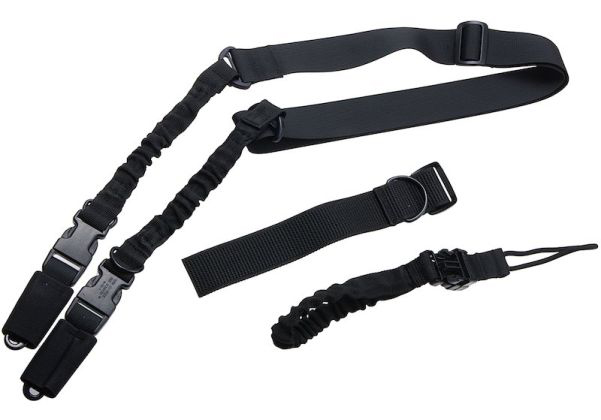
Three point slings are a more complex design that aims to combine the features of the previous two slings though with a few caveats. Three-point slings go over your body like a two-point but have an extra loop in the middle that can be unclipped to have the mobility of a single point sling when necessary.
Three-point slings are very supportive slings that are ideal for heavier weapons; they offer a lot of control and provide a very secure attachment of the weapon to your body. As three point slings can be unclipped for more flexibility they can be ideal for transitions too while maintaining the hands free ability of two point slings when clipped to their tighter configuration.
However, three-point slings have a significantly larger number of straps and can get caught up on your gear very easily. This is because three point slings were designed prior to the heavy use of modern tactical gear such as body armour and MOLLE which wasn’t present during the Cold War. Three point slings also require a greater amount of adjustment with so many different straps forcing you to take time to adjust each strap to its ideal length to wear the sling correctly.
How to Install a Rifle Sling
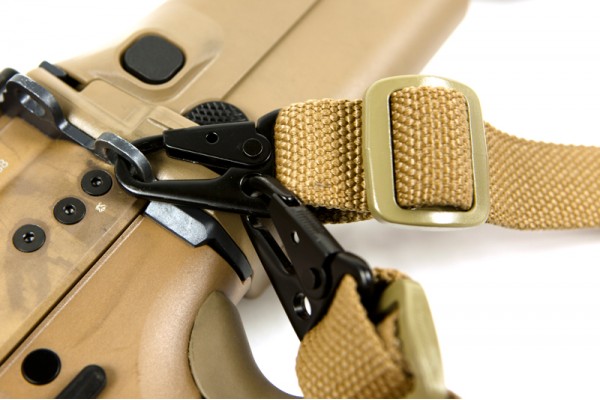
The most important thing to know when setting up your tactical rifle sling is that you have to adjust the length and test its functionality with the equipment you actually use prior to actually participating in competition shooting or an active airsoft game. This means that if you carry a plate carrier or vest, you need to test that sling with the gear on to get the correct adjustments as your body dimensions when wearing that gear will be different than just wearing a tshirt. This means it’s also possible that you will need to use different slings or sling setups regarding the weapon system you’re using or the specific situation you’re using it for.
How Do Rifle Slings Attach?
Slings come in many styles when it comes to mounting; the most basic kind of mount involves simple sling loops which can be found on many types of guns. Installing a sling via sling loops simply requires you to slide the sling through the loop and then fold it over and pull the strap through a buckle to keep it secure.
Some slings can come with mash hooks which secure to a ring type attachment on a gun. The mash hook is spring loaded and once you snap the hook in and it closes and will not come off until you depress the spring-loaded arm.
The last common attachment type is slings using a QD (quick detach) swivel. These have a traditional sling loop like the first type with a button built into it. The sling is attached into a QD socket and clicks into place through depressing a button on the sling attachment socket. Once it's clicked in, the loop cannot come out without you pressing that spring-loaded button on the socket.
What Side of the Rifle Do You Mount a Sling On?
The best sling mount locations are dependent on what you’re using the rifle for. If you’re using it for tactical purposes, then you’ll want to have a sling that can be quickly released and thus it would be ideal to mount the sling on the left side of the rifle allowing for your left hand to be free to unclip the sling if necessary. If you’re using your airsoft rifle for competition shooting, then you’ll want a more comfortable sling that can be easily adjusted which would be more ideally on the right side of the rifle.
How to Wear a Rifle Sling
How one wears a rifle sling largely depends on the type of sling being used, for single point slings the ideal method of wearing would be to loop the sling over the head and shoulder of the dominant arm to maintain maximum flexibility of use. For a two point sling the sling would ideally be looped over a single shoulder when travelling or over the head when doing extra tasks and not looped at all in a combat situation to maintain maximum level of movement. Three point slings are generally worn similar to single point slings but have an extra clip that allows the rifle to either be worn close to the body for additional hands free tasks or loose to allow for easier weapons manipulation and transitioning to secondaries.
What is the Best Rifle Sling for Airsoft?
We stock a number of slings of all types to suit your every need, these include both single point, two point and three point slings from various manufacturers and materials to ensure you as a player have the best options available for your personal play styles and specific airsoft guns. For example, the nHelmet Nylon MS3 Multi-Mission Single Point / 2 Point Sling is a multifunctional nylon sling that can be adjusted to either a single point or two point formats depending on the user’s preference or the weapon length. For players who want a more classic look, the Tanaka Leather Sling for Kar 98K Series comes in gorgeous brown genuine leather perfectly suited for more classical rifles of the early 20th century.

